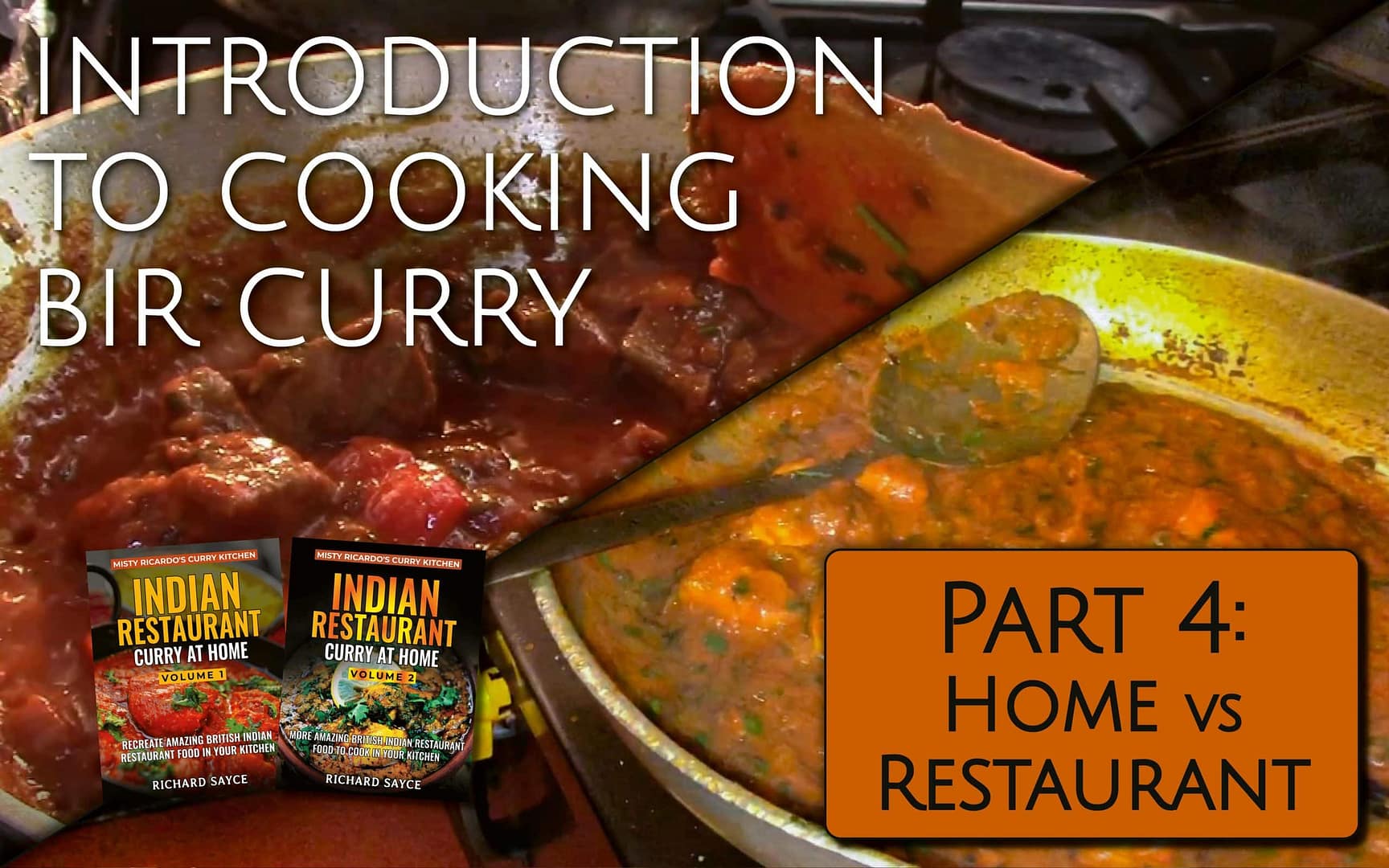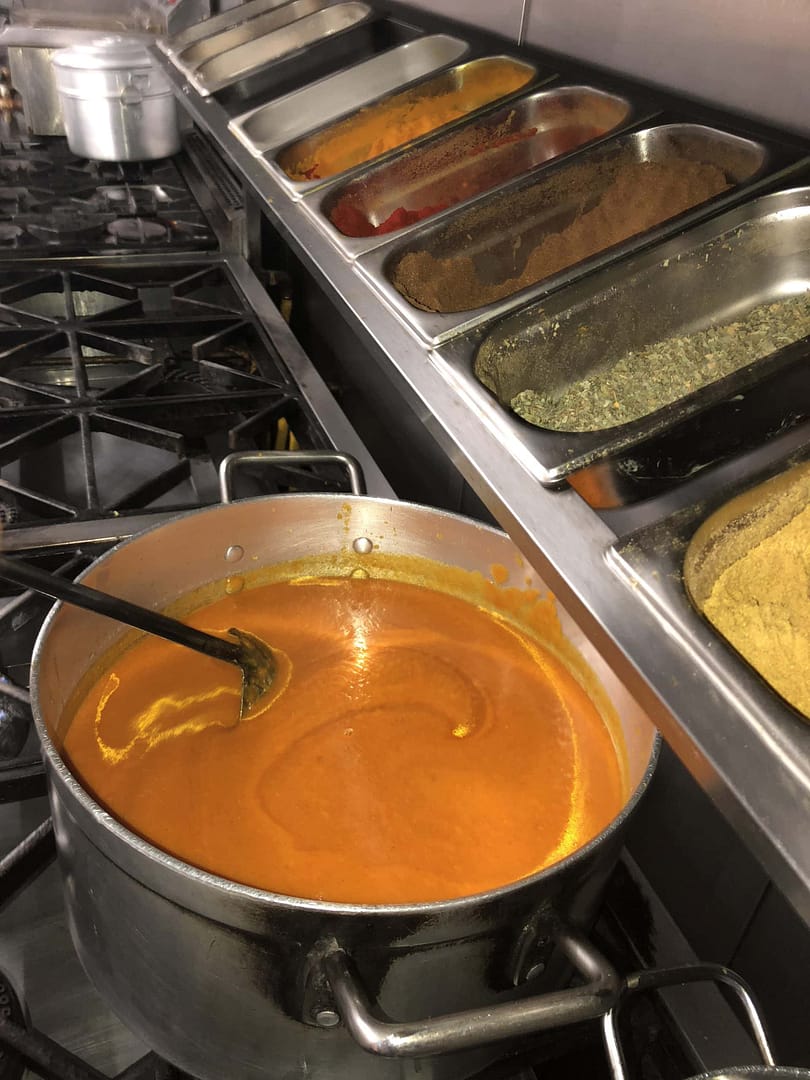Differences Between Cooking Curry in Restaurants and at Home
Although the basic approach is the same in both commercial and domestic kitchens, there are some significant differences.
Reproducing BIR food at home has less restraints on time (and cost). We can take more time to prep and cook, whereas commercial kitchens run on tight profit margins and need to churn food out fast. They must economise on ingredients and the attention to detail in cooking technique.
At home we have the benefit of extra time, both for prepping and for cooking the final dish itself. If we want to, we can make and prepare all the pre-cooked component ingredients well in advance and refrigerate or freeze them for future use.
We can decide what we want to have for supper the day before eating it, and prepare only the exact ingredients needed. Nobody will turn up while you are cooking and ask for a king prawn and okra zafrani with a duck egg omelette topping. Well, not very often!
In commercial kitchens powerful gas burners excel in funnelling heat into any pan that is placed on top. The high flame, while speeding up cooking time, has another crucial advantage over cooking curry at home: at higher temperatures special things are happening. The sauce is caramelising better, flavour compounds are produced in abundance, and everything in the frying pan marries together more harmoniously.
That single paragraph above explains (in my opinion) one of the main reasons why Indian restaurant and takeaway food tastes better than the average curry cooked at home using the same ingredients. I will say it again: HEAT is your friend.
In BIR kitchens oil is used in abundance. For example, deep fat fryer oil, having been used to repeatedly cook popular menu items such as onion bhajis, becomes heavily infused with the deep, rich flavour of spice. Rather than discarding it, the oil is used to enhance curries with an extra layer of flavour.
The ‘seasoned’ oil gives Indian restaurant and takeaway curries a notable advantage over those cooked in the home kitchen, which, of course, is not frying hundreds of onion bhajis a day.
At home, however, with the luxury of time there are special touches you can add to help lift a curry up a notch or two. An example of this is onion paste (also known as bunjarra), which is a fantastic condiment with a deep, rich, savoury flavour. When added it really does improve a curry.
Bunjarra is best made by slowly caramelising onions with oil and spices until a dark golden-brown colour. It takes a considerable amount of time and attention to get the best results, and for that reason, commercial BIR kitchens have little inclination or time to make it.
With the benefit of having more time and focus at home, we can pay special attention to technique to get the best flavour.
The Importance of Pre-Prepared Ingredients
Restaurant and takeaway kitchens work like an assembly line. The pressure is on to serve food to customers quickly, especially at busy times. There’s no time to cook meat or most vegetables from raw, so it’s vital that all the necessary ingredients have been pre-cooked or par-cooked, and are ready to be assembled with each order ready in 10 minutes or less.
If you have witnessed busy professional chefs cooking curries, you will have noticed how efficiently they work. With his (or her) long metal spoon, the chef rapidly transfers ingredients such as oil, chopped onion, pastes, spices, pre-cooked meats and vegetables from various nearby handy containers into a frying pan. A ladle rests in a large pot of warm base gravy within arm’s reach on the hob. When it’s needed the chef can quickly dip in and scoop some up to add to the curry.
BIR chefs often multi-task, cooking several curries at a time, with each at different cooking stages. He or she has no time to waste, and there’s too much going on to worry about chopping onions or making chicken tikka, for example. All the ingredients simply must be readily available and be replenished by other kitchen staff if running low.
The same principles also apply to the other BIR cooking stations. The tandoori chef must have all the marinated meat ready for the tandoori oven and all the proofed doughs ready to be rolled out to make naan, paratha, and chapati. Likewise for pre-cooked plain basmati, pilau rice, onion bhajis, poppadoms, dips, salad, and so on.
All this talk of pre-cooking and assembly may lead some to assume that this ‘fast food’ approach impacts on the quality. Of course, a lot of dishes cooked from scratch with raw ingredients will usually taste fresher, however there is a very desirable side-effect of the BIR way. I’m referring to the magic that happens in the frying pan when a curry is rapidly ‘assembled’ (using the right techniques), and that is mainly because of the way the powdered spices and base gravy are fried on high heat.
Without going into scientific detail, chemical reactions occur at high temperatures that create very flavourful compounds (especially from the onion content in the base gravy).
This article features sample content from my first book, Indian Restaurant Curry at Home Volume 1.







0 Comments